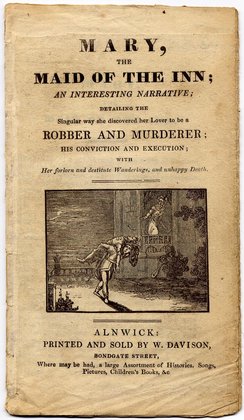Narrative
Popular Poets
20. In 1796, Southey composed a poem entitled Mary, The Maid of the Inn. The poem was composed using a traditional ballad form and tells the gothic tale of a woman driven mad by lost love. In his preface to the poem, Southey recalls first hearing the story of Mary, the Maid of the Inn when he was a schoolboy and indicates that the original tale is found in Dr. Pict’s History of Staffordshire (1817). This use of a story from his school days as poetic inspiration became a favored approach for Southey during his early literary career, as seen through the process of composition for both Madoc (1805) and The Curse of Kehama (1810). This 1820 chapbook for Southey’s Mary, The Maid of the Inn (1796) also features woodcut illustrations based on the ballad. As Popular Romanticism’s narrative on “Gothic Chapbooks” explains further, chapbooks simplified elaborate narrative structures and distilled literary themes, thus rendering texts accessible to the working classes. Consequently, the republication of Mary, The Maid of the Inn as a nineteenth-century chapbook is a testament to the persistent popularity of the ballad more than twenty years after its initial publication.


























